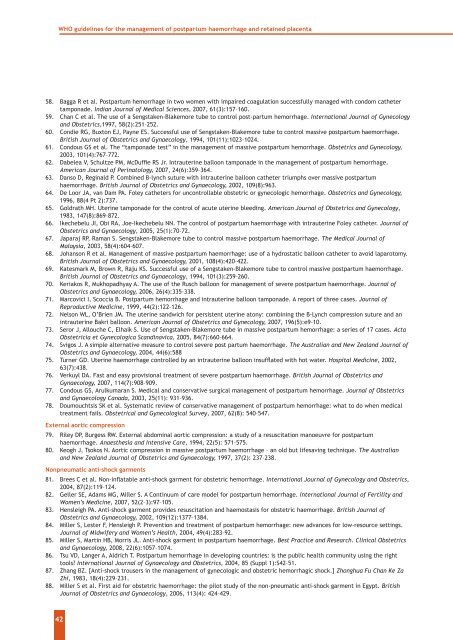WHO guidelines for the management of postpartum haemorrhage ...
WHO guidelines for the management of postpartum haemorrhage ...
WHO guidelines for the management of postpartum haemorrhage ...
Create successful ePaper yourself
Turn your PDF publications into a flip-book with our unique Google optimized e-Paper software.
<strong>WHO</strong> <strong>guidelines</strong> <strong>for</strong> <strong>the</strong> <strong>management</strong> <strong>of</strong> <strong>postpartum</strong> <strong>haemorrhage</strong> and retained placenta<br />
58. Bagga R et al. Postpartum hemorrhage in two women with impaired coagulation successfully managed with condom ca<strong>the</strong>ter<br />
tamponade. Indian Journal <strong>of</strong> Medical Sciences, 2007, 61(3):157–160.<br />
59. Chan C et al. The use <strong>of</strong> a Sengstaken-Blakemore tube to control post-partum hemorrhage. International Journal <strong>of</strong> Gynecology<br />
and Obstetrics,1997, 58(2):251–252.<br />
60. Condie RG, Buxton EJ, Payne ES. Successful use <strong>of</strong> Sengstaken-Blakemore tube to control massive <strong>postpartum</strong> <strong>haemorrhage</strong>.<br />
British Journal <strong>of</strong> Obstetrics and Gynaecology, 1994, 101(11):1023–1024.<br />
61. Condous GS et al. The “tamponade test” in <strong>the</strong> <strong>management</strong> <strong>of</strong> massive <strong>postpartum</strong> hemorrhage. Obstetrics and Gynecology,<br />
2003, 101(4):767–772.<br />
62. Dabelea V, Schultze PM, McDuffie RS Jr. Intrauterine balloon tamponade in <strong>the</strong> <strong>management</strong> <strong>of</strong> <strong>postpartum</strong> hemorrhage.<br />
American Journal <strong>of</strong> Perinatology, 2007, 24(6):359–364.<br />
63. Danso D, Reginald P. Combined B-lynch suture with intrauterine balloon ca<strong>the</strong>ter triumphs over massive <strong>postpartum</strong><br />
<strong>haemorrhage</strong>. British Journal <strong>of</strong> Obstetrics and Gynaecology, 2002, 109(8):963.<br />
64. De Loor JA, van Dam PA. Foley ca<strong>the</strong>ters <strong>for</strong> uncontrollable obstetric or gynecologic hemorrhage. Obstetrics and Gynecology,<br />
1996, 88(4 Pt 2):737.<br />
65. Goldrath MH. Uterine tamponade <strong>for</strong> <strong>the</strong> control <strong>of</strong> acute uterine bleeding. American Journal <strong>of</strong> Obstetrics and Gynecology,<br />
1983, 147(8):869–872.<br />
66. Ikechebelu JI, Obi RA, Joe-Ikechebelu NN. The control <strong>of</strong> <strong>postpartum</strong> <strong>haemorrhage</strong> with intrauterine Foley ca<strong>the</strong>ter. Journal <strong>of</strong><br />
Obstetrics and Gynaecology, 2005, 25(1):70–72.<br />
67. Japaraj RP, Raman S. Sengstaken-Blakemore tube to control massive <strong>postpartum</strong> <strong>haemorrhage</strong>. The Medical Journal <strong>of</strong><br />
Malaysia, 2003, 58(4):604–607.<br />
68. Johanson R et al. Management <strong>of</strong> massive <strong>postpartum</strong> <strong>haemorrhage</strong>: use <strong>of</strong> a hydrostatic balloon ca<strong>the</strong>ter to avoid laparotomy.<br />
British Journal <strong>of</strong> Obstetrics and Gynaecology, 2001, 108(4):420–422.<br />
69. Katesmark M, Brown R, Raju KS. Successful use <strong>of</strong> a Sengstaken-Blakemore tube to control massive <strong>postpartum</strong> <strong>haemorrhage</strong>.<br />
British Journal <strong>of</strong> Obstetrics and Gynaecology, 1994, 101(3):259–260.<br />
70. Keriakos R, Mukhopadhyay A. The use <strong>of</strong> <strong>the</strong> Rusch balloon <strong>for</strong> <strong>management</strong> <strong>of</strong> severe <strong>postpartum</strong> <strong>haemorrhage</strong>. Journal <strong>of</strong><br />
Obstetrics and Gynaecology, 2006, 26(4):335–338.<br />
71. Marcovici I, Scoccia B. Postpartum hemorrhage and intrauterine balloon tamponade. A report <strong>of</strong> three cases. Journal <strong>of</strong><br />
Reproductive Medicine, 1999, 44(2):122–126.<br />
72. Nelson WL, O’Brien JM. The uterine sandwich <strong>for</strong> persistent uterine atony: combining <strong>the</strong> B-Lynch compression suture and an<br />
intrauterine Bakri balloon. American Journal <strong>of</strong> Obstetrics and Gynecology, 2007, 196(5):e9–10.<br />
73. Seror J, Allouche C, Elhaik S. Use <strong>of</strong> Sengstaken-Blakemore tube in massive <strong>postpartum</strong> hemorrhage: a series <strong>of</strong> 17 cases. Acta<br />
Obstetricia et Gynecologica Scandinavica, 2005, 84(7):660–664.<br />
74. Svigos J. A simple alternative measure to control severe post partum <strong>haemorrhage</strong>. The Australian and New Zealand Journal <strong>of</strong><br />
Obstetrics and Gynaecology, 2004, 44(6):588<br />
75. Turner GD. Uterine <strong>haemorrhage</strong> controlled by an intrauterine balloon insufflated with hot water. Hospital Medicine, 2002,<br />
63(7):438.<br />
76. Verkuyl DA. Fast and easy provisional treatment <strong>of</strong> severe <strong>postpartum</strong> <strong>haemorrhage</strong>. British Journal <strong>of</strong> Obstetrics and<br />
Gynaecology, 2007, 114(7):908–909.<br />
77. Condous GS, Arulkumaran S. Medical and conservative surgical <strong>management</strong> <strong>of</strong> <strong>postpartum</strong> hemorrhage. Journal <strong>of</strong> Obstetrics<br />
and Gynaecology Canada, 2003, 25(11): 931–936.<br />
78. Doumouchtsis SK et al. Systematic review <strong>of</strong> conservative <strong>management</strong> <strong>of</strong> <strong>postpartum</strong> hemorrhage: what to do when medical<br />
treatment fails. Obstetrical and Gynecological Survey, 2007, 62(8): 540–547.<br />
External aortic compression<br />
79. Riley DP, Burgess RW. External abdominal aortic compression: a study <strong>of</strong> a resuscitation manoeuvre <strong>for</strong> <strong>postpartum</strong><br />
<strong>haemorrhage</strong>. Anaes<strong>the</strong>sia and Intensive Care, 1994, 22(5): 571–575.<br />
80. Keogh J, Tsokos N. Aortic compression in massive <strong>postpartum</strong> <strong>haemorrhage</strong> – an old but lifesaving technique. The Australian<br />
and New Zealand Journal <strong>of</strong> Obstetrics and Gynaecology, 1997, 37(2): 237–238.<br />
Nonpneumatic anti-shock garments<br />
81. Brees C et al. Non-inflatable anti-shock garment <strong>for</strong> obstetric hemorrhage. International Journal <strong>of</strong> Gynecology and Obstetrics,<br />
2004, 87(2):119–124.<br />
82. Geller SE, Adams MG, Miller S. A Continuum <strong>of</strong> care model <strong>for</strong> <strong>postpartum</strong> hemorrhage. International Journal <strong>of</strong> Fertility and<br />
Women’s Medicine, 2007, 52(2–3):97–105.<br />
83. Hensleigh PA. Anti-shock garment provides resuscitation and haemostasis <strong>for</strong> obstetric <strong>haemorrhage</strong>. British Journal <strong>of</strong><br />
Obstetrics and Gynaecology, 2002, 109(12):1377–1384.<br />
84. Miller S, Lester F, Hensleigh P. Prevention and treatment <strong>of</strong> <strong>postpartum</strong> hemorrhage: new advances <strong>for</strong> low-resource settings.<br />
Journal <strong>of</strong> Midwifery and Women’s Health, 2004, 49(4):283–92.<br />
85. Miller S, Martin HB, Morris JL. Anti-shock garment in <strong>postpartum</strong> <strong>haemorrhage</strong>. Best Practice and Research. Clinical Obstetrics<br />
and Gynaecology, 2008, 22(6):1057–1074.<br />
86. Tsu VD, Langer A, Aldrich T. Postpartum hemorrhage in developing countries: is <strong>the</strong> public health community using <strong>the</strong> right<br />
tools? International Journal <strong>of</strong> Gynaecology and Obstetrics, 2004, 85 (Suppl 1):S42–51.<br />
87. Zhang BZ. [Anti-shock trousers in <strong>the</strong> <strong>management</strong> <strong>of</strong> gynecologic and obstetric hemorrhagic shock.] Zhonghua Fu Chan Ke Za<br />
Zhi, 1983, 18(4):229–231.<br />
88. Miller S et al. First aid <strong>for</strong> obstetric <strong>haemorrhage</strong>: <strong>the</strong> pilot study <strong>of</strong> <strong>the</strong> non-pneumatic anti-shock garment in Egypt. British<br />
Journal <strong>of</strong> Obstetrics and Gynaecology, 2006, 113(4): 424–429.<br />
42
















